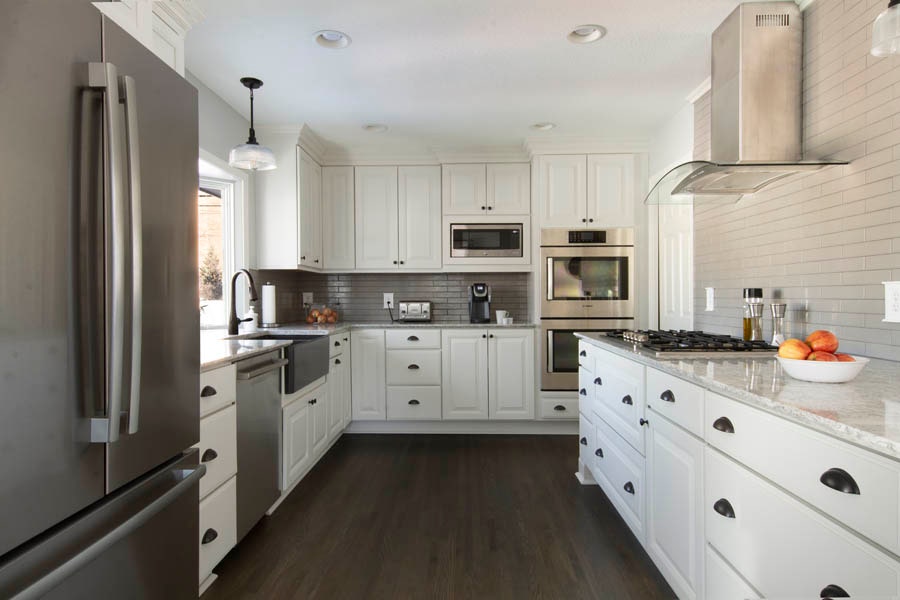Remodeling Resource Center
Resources to help you through your project.
Read More


Kitchen remodeling can come with an overwhelming number of questions and tasks. So why choose custom cabinets? Out of all the cabinet options for your kitchen remodel, custom cabinets are the most flexible and offer the largest variety of options to meet your needs. Here we will explore what to look for when choosing custom cabinets, how you can personalize them and much more.


Custom cabinetry is an essential ingredient for personalized kitchen design. High-quality craftsmanship gives you the ability to tailor any space to your needs. Often, this includes the power to choose the type of wood, finish, storage solutions, and size needed for your specific space. That means the kitchen or bathroom remodel won't just be functional; it will be a reflection of your personality.
Quality custom cabinetry can be crafted to your exact specifications, giving you complete control over every detail. Modifications can also be made from the choice of construction and finishes to layout and storage solutions. Construction typically involves dovetail drawer boxes, thicker cabinet boxes, full-height back panels and more. Custom cabinetry provides the freedom to create a kitchen or bathroom that not only looks amazing but functions well.
Stock cabinets are pre-made, mass-produced kitchen cabinets that come in standard sizes and designs. They are the ready-to-go, big-box store option for those looking for a cost-effective solution for their kitchen. Construction usually consists of thin furniture board with half-depth shelves and joinery that is glued and stapled. Stock cabinets are available in a limited range of styles, finishes, and sizes, making them suitable for standard kitchen layouts.
RTA, or Ready-to-Assemble cabinets, are a popular choice in kitchen design due to their affordability and convenience. These cabinets are typically flat-packed and shipped to the customer, then need to be assembled on-site. RTA construction can range from furniture board to all-plywood with dovetail joinery depending on the manufacturer.
In order to design your own kitchen’s custom cabinetry, it’s important to learn what your specific needs are. Do you like pantries and deep drawer bases for storage? Do you prefer floating shelves? Is your favorite color scheme neutral or bold? Start by creating a wish list and budget. By doing this, you will start your project knowing exactly what you want and how much you are willing to spend.


When you are ready to get started, hire a professional kitchen designer who can help you. Talk about everything from your measurements and style to the lead time. If there is a specific timeline that you must keep, discuss it right away so you know if the cabinet company can accommodate your project.
Cabinetry is a very permanent home fixture so make sure it’s done properly. Designers know exactly what questions to ask to make your dream a reality, while accounting for kitchen design elements and guidelines that keep you safe. Here is a snapshot of what a typical custom cabinet design process looks like.


- Submit measurements
- Meet your designer
- Initial design review
- Design revisions and review
- Final design approval
- Order cabinetry
- Delivery day
Among the many benefits of custom cabinets is the sheer width of options. One of those includes wood selection. The most common wood types for custom cabinets are cherry, oak, hickory, maple and MDF. Other rare and potentially more expensive options are knotty alder, walnut, mahogany and birch wood. Here are the common characteristics of each standard wood type.


Cherry: This is a hardwood with closed grain that varies from dramatic red to reddish brown. Over time this wood will darken as it ages.
Oak: This wood has a more rigid open-grain pattern. Oak’s color is typically a golden hue with slight red undertones.
Hickory: This is a hardwood with large color variation. Color differences can include a blonde hue to bold reddish-brown tones.
Maple: This is a hardwood with an open grain pattern. Maple wood cabinets are blonde in color with lighter natural wave patterns.
MDF: Since MDF is a composite wood, this has no grain pattern or color. This choice is commonly used for silky smooth painted finishes on slab door styles.
During the search for custom cabinets, look for cabinet makers who use climate-controlled spaces that are dedicated to the finishing process. Quality finishes are catalyzed or lacquer finishes creating a furniture-like finish that we all love. These options will provide a long-lasting finish that is durable and rich in color. Cabinet companies who care about craftsmanship and quality will have a controlled process like the following 11-step finishing process.
- Wood Selection
- Sanded to Perfection
- Paint Application
- Removal of Excess Paint
- Catalyzed Sealer
- Drying Process
- Hand-sanded
- Dust Removal
- Catalyzed Top Coat
- Final Top Coat Cure
- Final Inspection
When cabinet manufacturers are transparent with their processes, it makes the design and selection of products much more exciting.
One major feature of your new cabinets to pay attention to is cabinet construction. This can make or break the life of cabinets and tell you a lot about the cabinet maker. When shopping for quality custom cabinets, look for features like ½-inch thick side panels, full-height back panels and I-beam construction.
These are all details that create strong cabinet boxes that can last a lifetime. Other features include soft-close cabinet hinges and drawer glides, dovetail drawer box construction and water-proof natural maple laminate interiors.
Most companies will have different levels of cabinet box construction to choose from. Furniture board is usually the standard option with an optional all-plywood upgrade. Both materials are durable, however all-plywood can be better in spaces where water sources like sinks are present.


Storage is a hot topic in kitchen design. Either there is a lack of space or opportunity to improve organization. But one thing is for sure, cabinet accessories can make all the difference. Custom cabinet manufacturers offer a wide selection of storage solutions to meet almost every possible need. Things like pull-out waste containers, cutlery dividers, pull-out pantry solutions and spice racks are just a few common options.
In addition to cabinet construction, it’s easy to see a quality custom cabinet from a mile away. Their cabinet accessories can be customized based on size and will be made from durable materials. For example, hardwood or plywood lazy susans and spice racks, soft-close ball-bearing glides, and quality metal materials like chrome rails or powder-coated metal racks are all staples of durable accessories. Storage solutions need to stand up to lots of use and abuse, so make sure your cabinet accessories are using these materials.
Every remodel always has a ‘budget talk’. Some budgets might be bigger than others, but the fact is every project has a ceiling. When the time comes, there are a few easy ways to save money.
During the design process, it’s easy to get excited about all the options and touch real-life cabinet samples. In the excitement, some homeowners over-do it and don’t realize the cost of custom cabinetry starts adding up. Focus on cabinet accessories you need to improve how your kitchen functions and go from there. Your designer should be providing itemized cabinet pricing so you can see when price changes occur and how much they add to your bill.


When kitchen cabinets show up, they will probably need some adjustments. Cabinets that get shipped across country get shaken up during transit and typically need to be realigned. This involves realigning drawer boxes and door hinges. Cabinet makers usually provide a guide to help you, or your installer make these adjustments before the project is complete.
Taking care of custom cabinets is similar to standard care for RTA or stock cabinets. Daily cleaning is best to help avoid the buildup of grease and grime. Start by wiping down your new custom cabinets with a wet microfiber to wipe away dust, but use a mild diluted soap mixture for heavier spills. Avoid using microfibers with bright colors to prevent potential color transfer onto your cabinets. Keep in mind that cleaners with chemicals, wax bases, silicone bases, bleach and scouring pads will damage the beautiful satin finish.
Finding the right cabinet maker always starts with research. Scour the internet and look at reviews on Yelp, the Better Business Bureau and Google. See what people are saying on social media as well so you can gain insight into the customer experience.
Another great way is by looking through the manufacturer's gallery or project portfolio. This could also include photos posted by their customers on social media. Projects with before and after photos will show you what the company’s capabilities are as well as the design staff’s creativity.
After you have vetted the cabinet company, talk with their designers about current lead times and what they will provide. Companies that are transparent with lead times, itemized pricing, and communicate with their customers are more likely to have great reviews and get referrals.
Finding the perfect custom cabinets for your kitchen remodel may have seemed overwhelming before. But now that you know what cabinet quality and characteristics to look for in a manufacturer, the journey will be simple.
CliqStudios offers a wide range of custom cabinets with high-quality cabinet construction, cabinet accessories, free professional design and transparency. View our custom cabinets to start your exploration process today!

Take the first step toward your dream kitchen today! We’ll connect you with your personal designer to make your project a reality.
Let’s Get StartedStarting the process of a kitchen or bathroom remodel is easier than it sounds. First, create a wish list and budget. If you are not sure what your budget is, bring this concern along with your wish list to a CliqStudios designer. They are professionals and provide free design expertise while guiding you towards the perfect cabinet line for your budget. Once you connect with a designer, they will walk you through the design process helping you select the right cabinet sizes, cabinet accessories and finishes for your space. Get started today!
In most cases, you can choose the wood type and finish for your custom cabinetry. Typically, wood selection is only limited with painted finishes because the manufacturer selects a standard choice that helps create a smooth finish on your door style. Sometimes the manufacturer will provide a few different options if the finish is a sheer paint so you can decide which type of wood grain will show through.
Every cabinet manufacturer should offer 3D renderings and floor plans of your order before you place your order. This is typically an industry standard. CliqStudios even offers free design services in addition to the visuals so you can speak with a professional designer and feel confident in your remodeling decisions. Speak with a CliqStudios designer today to get started!
Since custom cabinetry is completely unique, the lead time can vary. For projects with minimal modifications and mostly standard cabinet sizes, the average lead time is 5 – 7 weeks. Longer lead times for custom cabinet orders could be anywhere from 7 – 9 weeks. At the start of your project, speak with your designer about lead times and re-confirm before you order. The best way to prevent surprises is to stay informed.
There are selection differences between stock, semi-custom and custom cabinets. The best time to choose custom cabinetry is when your project has very complex needs that can’t be filled by semi-custom or stock cabinet options. Custom cabinetry is also your best solution when you and your designer keep struggling to solve design issues with stock cabinets and semi-custom cabinets. Although custom cabinets can be more expensive, the ability to personalize them without limitations will benefit you the most.